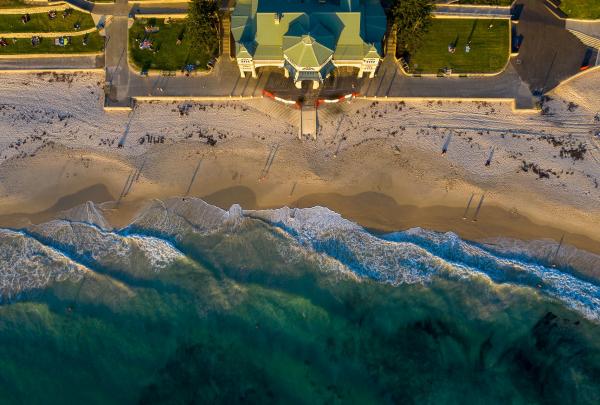
Powering up the next decade: Renewable energy in Australia
Australia is known worldwide for its surf beaches and sunshine, both of which can be tapped as renewable energy resources and, when combined with advancing technology, suggest a promising decade ahead for renewable energy in Australia.
Last year, the renewable proportion of Australia’s total electricity generation rose to 21.3 percent, up from 8.7 percent in 2010. Of that 21.3 percent, almost 60 percent of this came from wind and solar.
Shining a light on Australia’s solar sector
Australia’s high solar insolation – the technical term for having a lot of usable sunshine – coupled with the popularity of solar panels, makes this sector very productive. Large-scale solar power generation in Australia surged by 135 per cent last year according to The Australian Energy Statistics released in May 2020.
Leading innovation is coming out of the University of New South Wales’ School of Photovoltaic and Renewable Energy Engineering. The Centre was established by Professor Martin Green who was the first Australian to receive the prestigious Global Energy Prize in 2018. The judges commented that Green and the Centre were honoured for having revolutionised the efficiency and costs of solar photovoltaics, making this now the lowest cost option for bulk electricity supply.
Added to this, Professor Green was awarded the 2021 Japan Prize in the category of “Resources, Energy, the Environment, and Social Infrastructure”, recognising the more than four decades of research undertaken at UNSW, that has led to developed technologies now ubiquitous in most commercially available solar panels.
Australian organisations have also invented solar energy technologies including evacuated tubes - used to store solar energy – as well as concentrating solar technologies such as the Compact Linear Fresnel Reflector (CLFR). CLFR technology was developed at University of Technology Sydney as an evolution to the original Fresnel reflector - a system that concentrates the sun’s radiation into a receiver and generates high temperature media for thermal power generation. The CLFR design helps to avoid shading - an issue with the original Fresnel reflector.
Current development efforts are focussed on next generation technologies such as flexible solar cells which can ultimately be placed on different materials including curved surfaces, glass, metal and even fabrics. There is also significant industry activity in developing and delivering solar hybrid technologies to seamlessly integrate solar into existing networks, operations or off-grid applications saving households and companies set up costs. Hybrid technologies also act as a successful backup power supply during a blackout.
The monitoring and control of solar technologies is another area where Australian organisations are providing world-leading technologies. These include Fulcrum3D’s CloudCAM, an innovative cloud cover measurement and forecasting system that predicts short-term power fluctuations from solar PV systems, enabling solar installations to be integrated more easily into networks globally.
In Australia’s ‘Red Centre’ near Alice Springs, the Desert Knowledge Australia (DKA) precinct is home to organisations and initiatives creating opportunities for desert communities around the world.

Fast Fact
The Intyalheme Centre for Future Energy will open near Alice Springs as part of the Desert Knowledge Australia precinct.

Alice Springs, Australia’s Red Centre, Northern Territory © Tourism Australia
DKA is set to become a global trailblazer in renewable energy research and knowledge with the opening of the Intyalheme Centre for Future Energy. The centre works across three main focus areas: delivering collaborative projects that conceptualise and validate future grid options (technologies, systems, networks, commercial and market partnerships); being a conduit (facilitating connections, providing advice, linking projects and people); and, sharing knowledge (community education and engagement, disseminating targeted information to enhance renewable energy capability).
“Through the Centre, we will provide access to the knowledge and expertise that’s driving innovation, growth and thinking around smart energy delivery in regional and remote Australia,” says Lauren Ganley, DKA’s Chief Executive Officer.
The Intyalheme Centre is governed by a consortium of five partner organisations: Desert Knowledge Australia; the Australian Government’s Department of Primary Industry and Resources; Ekistica; Power and Water Corporation; and Charles Darwin University.
“The Centre sits in the band of the most intense solar radiation in the country, and we have clear, cloudless skies, so we are able to capture very consistent data that has relevance globally,” says Ganley.
Wide open spaces gives Australia its natural advantage for the wind sector
Wind power is well suited to Australia’s wide, open spaces, strong coastal breezes close to populated centres and a supportive regulatory framework. As a result, some regions of Australia have wind energy penetration that provides nearly 30 per cent of electricity needs. This has required extensive modelling and network design to ensure grid stability and reliability is maintained.
Did you know?
Strong coastal breezes close to population centres make Australia well suited to harnessing wind power as a renewable energy source. Western Australia’s largest wind farm is under construction 175 kilometres (109 miles) north of Perth.


Cottesloe Beach, Perth, Western Australia © Tourism Australia
Australia’s expertise in the design, monitoring and modelling of wind farm projects, along with leading community engagement processes, is enabling the sector to continue its strong growth.
The development of wind farms is supported by a mature regulatory environment and well-developed grid connection processes to facilitate efficient project completion and commissioning.
An Australian innovation to accelerate site design has been the replacement of monitoring masts with ground-based SODAR (Sonic Detection And Ranging) systems such as those provided by Fulcrum3D. This portable wind monitoring system measures wind speeds in three dimensions and at high accuracy up to 200 metres above ground level. This provides a better understanding of the wind profile at a wind farm site allowing for faster and more accurate wind farm development.
Another Australian technology improving wind farm development is world-leading atmospheric modelling and wind energy assessment technology developed by Australia’s national science agency, CSIRO, and delivered by Windlab Systems. Windlab now uses this wind energy prospecting and assessment tool to identify and efficiently develop high-quality wind farm sites with greater certainty and less risk, in Australia and globally.
Looking ahead to a new decade in Australian renewable energy
Australia’s renewable energy sector is looking forward to a bright decade ahead with increased focus into a National Hydrogen Strategy and landmark projects including the Sun Cable project in the Northern Territory and the Asia Renewable Energy Hub in Western Australia.
It is expected that by the end of 2020, Australia would have reached its original Renewable Energy Target of 41,000 gigawatt hours per annum.

















